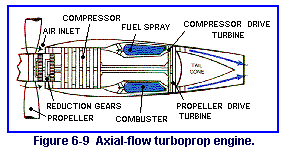 |
|||||
| Home | Research | For Teachers | HISTORY Level 1 Level 2 Level 3 |
PRINCIPLES Level 1 Level 2 Level 3 |
CAREER Level 1 Level 2 Level 3 |
| Gallery | Hot Links | What's New! | |||
| Web Administration and Tools | |||||
 |
|||||
| Home | Research | For Teachers | HISTORY Level 1 Level 2 Level 3 |
PRINCIPLES Level 1 Level 2 Level 3 |
CAREER Level 1 Level 2 Level 3 |
| Gallery | Hot Links | What's New! | |||
| Web Administration and Tools | |||||
![]()
The turboprop engine is an effort to combine the best features of turbojet and propeller aircraft. The first is more efficient at high speeds and high altitudes; the latter is more efficient at speeds under 400 mph and below 30,000 feet. The turboprop uses a gas turbine to turn a propeller. Its turbine uses almost all the engine's energy to turn its compressor and propeller, and it depends on the propeller for thrust, rather than on the high-velocity gases going out of the exhaust. Strictly speaking, it is not a jet. Study Figure 6-9 and note how the turbine turns the compressors and the propeller.
| The gas turbine can turn a propeller with twice the power of a reciprocating engine. Reduction gears slow the propeller below the turbine's rpm, and this must be done because of the limitations of propellers. That is, no propeller is capable of withstanding the forces generated when it is turned at the same rate as that of the gas turbine. Even so, the turboprop engine receives fairly extensive use in military and civilian aviation circles. |  |
In summary, aircraft turbine engines may be classified as turbojet, turbofan, or turboprop. As a group, the turbine engines have many advantages over reciprocating engines, the most obvious being the capability of higher-altitude and higher-speed performance. Vibration stress is relieved as a result of rotating rather than reciprocating parts. Control is simpler because one lever controls both speed and power. With the large airflow, cooling is less complicated. Spark plugs are used only for starting, and the continuous ignition system of reciprocating engines is not needed. A carburetor and mixture control are not needed.
The major disadvantages have been the high fuel consumption and poor performance at low power setting, low speeds, and low altitudes. Turboprop and turbofan developments have greatly improved aircraft turbine engines in these areas.
Send all comments to ![]() aeromaster@eng.fiu.edu
aeromaster@eng.fiu.edu
© 1995-98 ALLSTAR Network. All rights reserved worldwide.
| Funded in part by | From Civil Air Patrol Educational Materials |
Updated: February 23, 1999